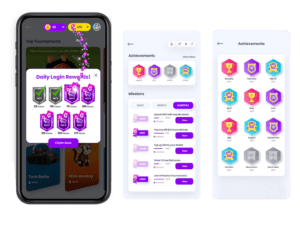The telecommunication market has seen tremendous growth in the past decade, riding the smartphone wave. 4G and LTE generations have matured, giving way to the current dogfights for 5G supremacy. In the US alone, the number of smartphones in active use rose from 50 million in 2009 to a staggering 300 million in 2019 and is now projected to reach 311 million by 2025. Increased competition caused by this uptick has increased the urgency for industry veterans to look for ways to attract and retain more users, and gamification has stepped in to fill the need. Game mechanics coupled with smart incentivization and social media integration have helped many sectors see significant growth. Telecom giants are now hoping to introduce some of the same mojos in their sector as well. Let’s look at how the telecom industry can benefit from gamification strategies.
How Gamification helps in Telecom:
Gamification provides quite a few niche benefits, and here’s how those boost the players in the telecom industry:
- Gamification drives user engagement. This user can be an external visitor to an organization’s internet-based site, or an employee accessing intranet resources.
- For employees, gamification has been seen to improve morale and job satisfaction.
- Incentivization strategies in gamification increase user interactivity and increase their loyalty. Customers are bound to stick with a product/service longer that provides instant gratification via badges and other rewards.
- For organizations, implementing gamification mechanics increases the effectiveness of internal training, accelerates the process of employee onboarding as well as increases employee productivity.
- Companies can get valuable insights about their user base by analyzing the permissions-based data shared by the customers. Users consent to sharing this data while engaging in different interactive tasks like trivia, QnA, etc.
- User data analysis helps organizations to customize their products to serve their users better.
- Through gamification, companies can boost their brand awareness and deliver messages tied to their specific marketing campaigns.
Some recent examples:
Gamification in business is not a new concept, and the telecom sector has reaped the benefits of implementing gameplay mechanics into its business processes to amass more user engagement and retention. Some recent examples include:
Verizon Wireless in 2012 decided to gamify its website to tackle low user engagement. The revamping duties for the Verizon Insider Web Portal were given to Gigya, a popular gamification vendor via a digital agency named Modal. Verizon, then with more than 108 million subscribers, was trying to engage more users via social media integration. Modal helped build Verizon Insider – an online hub for lifestyle and entertainment aimed to house all events, contests, sponsorships, and social initiatives that Verizon Wireless took – while Gigya worked on seamlessly integrating social and gamification features through features like social media logins, comments, and sharing. As part of this program, a milestones-based, tasks and rewards regimen was built. Users could get awarded with badges for commenting on articles and sharing them, and unlock better rewards if they referred them to more people.
The results were very promising. More than 50% of the site’s users engaged with the gamified content, and users who logged in via their social media accounts spent on average 30% more time versus users who used regular, older logins. These users who used social media logins generated 15% more page views.
Samsung in 2011 paved the way for gamification in the consumer electronics and telecom industry by adding game-like elements to incentivize user engagement in their corporate website. Dubbed ‘Samsung Nation’, members could earn points, unlock various rewards including badges, and get featured on the leaderboard by engaging and completing various activities like watching videos, commenting on different articles, and opting for various social media-specific tasks like liking posts, tweeting/retweeting about Samsung products, and even participating in user-generated Q&As on Samsung’s U.S website. Samsung also sweetened the pot by offering three Samsung Galaxy tablets to three lucky users who entered the sweepstakes.

—
Gamification has changed the way organizations look at user engagement. Traditional methods of marketing have given way to newer, game-derived mechanics to attract visitors and turn them into loyal customers. The telecom industry – although going through the most prolific decade in recent history – has recently found it difficult to expand its user demographic by using traditional methods and has started adopting gamification strategies. The rewards have also been handsome: incentivized loyalty programs have brought in more users, and permission-based information sharing has given organizations valuable insight about said users. But this is only the tip of the iceberg. As gamification strategies mature, many players in the current telecom industry will join the bandwagon. If you are a telecom market leader or a business owner, the time is now to leverage gamification and step up your user engagement.






